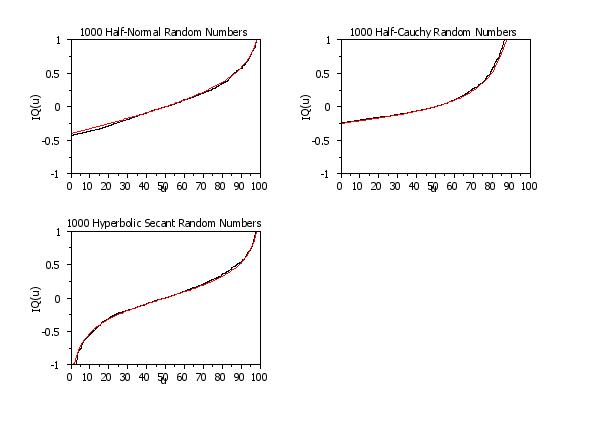

|
TRUNCATED INFORMATIVE QUANTILE PLOTName:
A univariate location-scale parametric distribution is one where the cumulative distribution function can be described as
with a and b denoting the location and scale parameters, respectively and F0 denotes the "standard" distribution (i.e., the location parameter is 0 and the scale parameter is 1). This means the distribution has no shape parameters. The 2-parameter lognormal is handled by taking the log of the data and then using the normal distribution. Similarly, the 2-parameter Weibull is handled by taking the log of the data and using the Gumbel distribution. The estimated IQ function is defined by
where Q(u) is the estimated quantile function (enter HELP EMPIRICAL QUANTILE PLOT for details). The corresponding exact function, denoted by IQ(u), replaces \( \hat{\mbox{Q}} \) with Q in the above formula. The estimated \( \hat{\mbox{IQ}} \) values are determined from the data while the exact IQ values are determined from a theoretical location-scale distribution (e.g., the normal, uniform, or Gumbel). The estimated truncated IQ function is defined by
This command plots the estimated truncated IQ function versus u and also plots the IQ function versus u for a specified theoretical distribution. The curve based on the data is compared to the curve for the theoretical distribution. The curve based on the data will typically be less smooth. However, the curves can be compared for general shape and tail behavior. Although the MIL-HANDBOOK-17 is primarily concerned with the normal, 2-parameter lognormal, and 2-parameter Weibull distributions, Dataplot supports this command for 19 different distributions. These plots are suggested as exploratory data analysis techniques in the MIL-HANDBK-17 (2002 edition). They were originally suggested by Parzen (see References below).
<SUBSET/EXCEPT/FOR qualification> where <dist> specifies the theoretical distribution and is one of:
LOGNORMAL UNIFORM GUMBEL WEIBULL LOGISTIC DOUBLE EXPONENTIAL CAUCHY SEMICIRCULAR COSINE ANGLIT HYPERBOLIC SECANT HALF-NORMAL ARCSINE EXPONENTIAL HALF-CAUCHY SLASH RAYLEIGH MAXWELL and where the <SUBSET/EXCEPT/FOR qualification> is optional. Note that the 2-parameter lognormal is handled by taking the log of the data and then using the normal distribution. The 2-parameter Weibull is handled by taking the log of the data and then using the Gumbel distribution. The log of the data will be taken by the Dataplot code, so you should not take the log of the data before entering this command.
WEIBULL TRUNCATED INFORMATIVE QUANTILE PLOT Y1 LOGNORMAL TIQ PLOT Y1
Parzen (1983), "Informative Quantile Functions and Identification of Probability Distribution Types", Technical Report No. A-26, Texas A&M University.
. Step 1: Define some default plot control features
.
title offset 2
title case asis
case asis
label case asis
line color blue red
multiplot scale factor 2
multiplot corner coordinates 5 5 95 95
.
. Step 3: Demonstrate TIQ PLOT
.
y1label IQ(u)
x1label u
title automatic
line solid solid
line color black red
character blank all
.
delete x
let n = 1000
let x1 = normal random numbers for i = 1 1 n
let x2 = exponential random numbers for i = 1 1 n
let x3 = double exponential random numbers for i = 1 1 n
let gamma = 2.7
let x4 = weibull random numbers for i = 1 1 n
multiplot 2 2
.
title ^n Normal Random Numbers
normal tiq plot x1
.
title ^n Exponential Random Numbers
exponential tiq plot x2
.
title ^n Double Exponential Random Numbers
double exponential tiq plot x3
.
title ^n Weibull Random Numbers
weibull tiq plot x4
.
end of multiplot

Date created: 06/29/2017 |
Last updated: 12/04/2023 Please email comments on this WWW page to [email protected]. | |||||||||||||||||||||||||